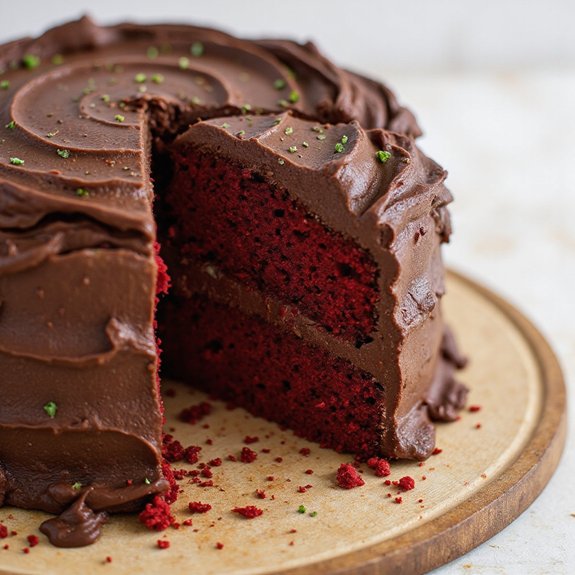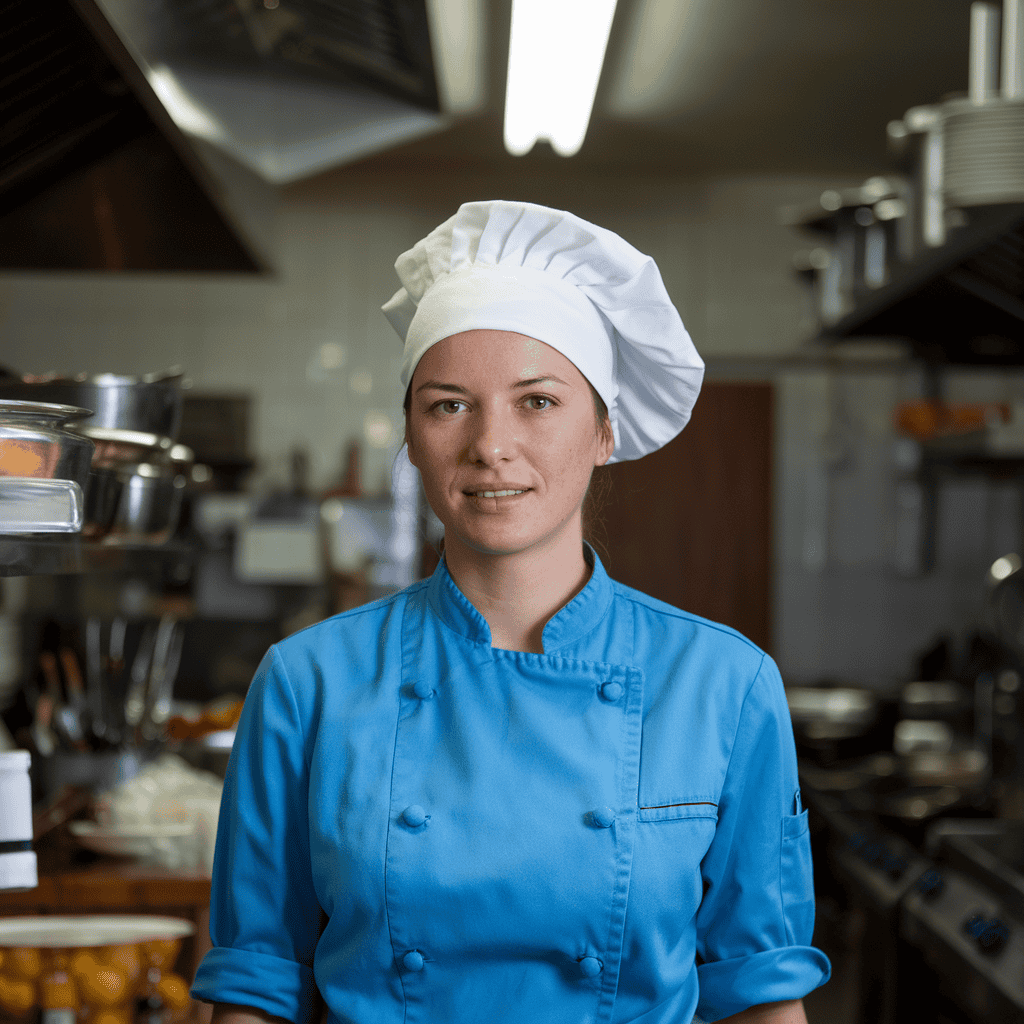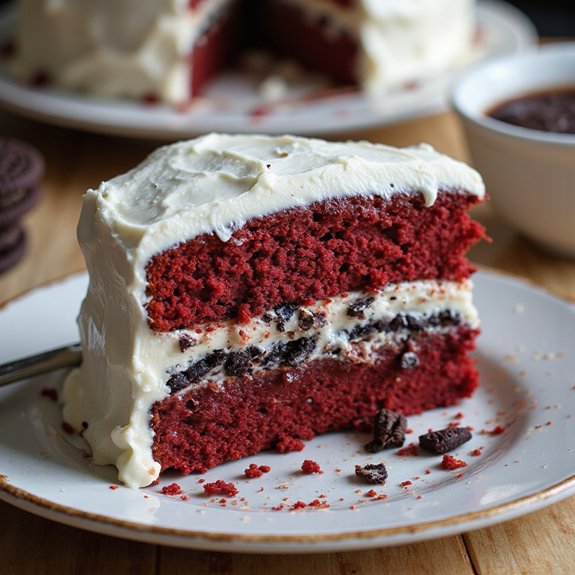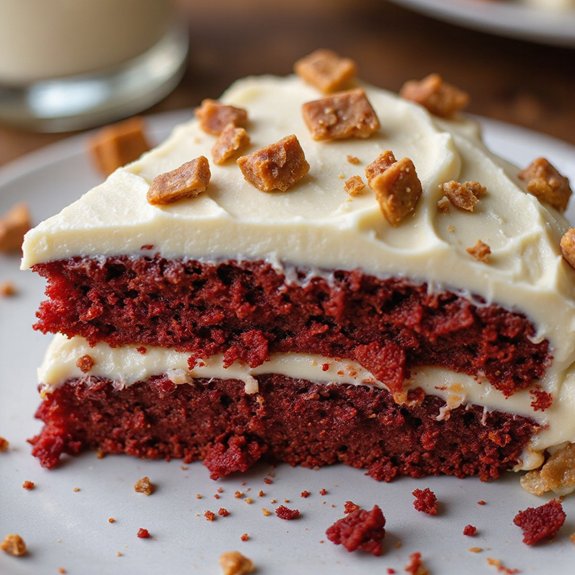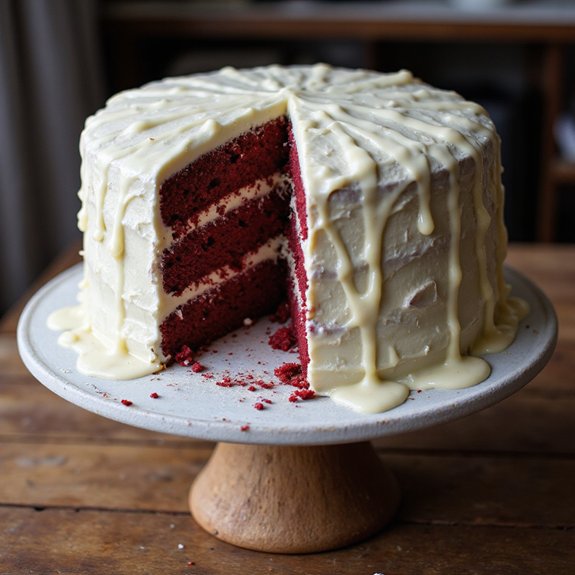Imagine slicing into a cake the color of deep garnet velvet, its tender crumb giving way to thick, glossy swirls of chocolate fudge frosting that smell like warm cocoa and comfort.
Picture the first forkful: moist, tangy layers meeting silky, fudgy richness—familiar yet indulgent—the kind of bite that hushes a room.
This cake matters to me because it’s where celebration meets solace, the dessert I lean on when I need a sure win and a little joy on a plate.
It’s perfect for busy weeknights that deserve a treat, Sunday suppers when family lingers, or any gathering where you want a dessert that looks stunning but feels like a hug.
Once, after a long week, this cake was my effortless showstopper—mixed in minutes, baked while we set the table, and frosted into silence at first bite.
Ready? Let’s cook!
Why You’ll Love It
- Delivers bold chocolate flavor without overpowering the red velvet
- Creates ultra-moist, tender crumb with bakery-style texture
- Spreads silky-smooth; sets into fudgy, slice-clean swirls
- Mixes easily with simple, accessible ingredients
- Stays fresh; make-ahead and fridge-friendly for days
Ingredients
- 2 1/2 cups all-purpose flour sifted — measure after sifting for accuracy
- 1 1/2 cups granulated sugar — fine grain dissolves evenly
- 1 teaspoon baking soda — check freshness for proper rise
- 1 teaspoon fine salt — balances sweetness
- 1 tablespoon natural cocoa powder — keeps cake’s red hue vibrant
- 1 1/2 cups vegetable oil — neutral flavor, adds moisture
- 1 cup buttermilk room temperature — tender crumb and tang
- 2 large eggs room temperature — better emulsification
- 2 tablespoons red liquid food coloring — use gel for deeper color if desired
- 1 teaspoon white vinegar — reacts with cocoa and soda
- 2 teaspoons vanilla extract — rounds out flavor
- 1/2 cup unsalted butter softened — for cake richness
- 1/2 cup unsalted butter cubed for fudge frosting — creams smoothly
- 1/2 cup vegetable shortening optional for extra tenderness — softer crumb
- 1 cup whole milk room temperature — for batter fluidity
- 2 cups powdered sugar sifted — lump-free frosting
- 1 cup sour cream room temperature — silky, tangy frosting body
- 8 ounces semisweet chocolate chopped — melts evenly for ganache
- 1/2 cup heavy cream — makes glossy ganache
- 1/4 cup cocoa powder Dutch-process for frosting — deep chocolate flavor
- 1/2 teaspoon fine salt for frosting — sharpens chocolate notes
- 1 teaspoon vanilla extract for frosting — aromatic finish
Step-by-Step Method
Preheat, Prep Pans
Preheat oven to 350°F. Line two 9-inch round pans with parchment circles. Lightly grease sides. Set a wire rack nearby. Gather tools and measure ingredients. Sift flour and powdered sugar separately. Bring buttermilk, eggs, milk, and sour cream to room temperature. Chop chocolate for ganache. Cube butter for frosting. Keep ingredients organized for a smooth workflow.
Whisk Dry Ingredients
Sift flour into a large bowl. Add granulated sugar, baking soda, fine salt, and natural cocoa powder. Whisk until evenly combined and lump-free. Assure leavening and salt are well dispersed. This prevents uneven rising and salty pockets. Set aside. Keep the bowl spacious for easy mixing when combining with wet ingredients later.
Blend Wet Ingredients
In a separate bowl, whisk vegetable oil, buttermilk, and eggs until smooth. Add red liquid food coloring, white vinegar, and vanilla extract. Whisk until cohesive and evenly colored. Assure no streaks remain. The vinegar reacts with baking soda for lift. Keep the mixture fluid and glossy for easy incorporation into the dry ingredients.
Combine to Batter
Pour wet mixture into dry ingredients. Mix on low speed just until a smooth batter forms. Scrape the bowl and paddle with a rubber spatula. Avoid overmixing to prevent toughness. Stop when no dry streaks remain. The batter should be pourable and even. Tap the bowl gently to release large air bubbles.
Divide & Pan
Split batter evenly between prepared pans. Weigh for accuracy if possible. Aim for equal layers. Smooth tops with a spatula. Tap each pan firmly on the counter to dislodge air bubbles. Check edges for even distribution. This step promotes flat, uniform cakes. Work swiftly to maintain leavening activity before baking.
Bake to Doneness
Place pans on the center rack. Bake 25–30 minutes. Rotate once if needed for even browning. Test with a toothpick; it should emerge with a few moist crumbs, not wet batter. The cakes will spring back lightly. Avoid overbaking to keep moisture. Remove to a wire rack when done.
Cool & Release
Cool cakes in pans for 10 minutes. Run a knife around edges if needed. Invert onto a wire rack. Peel away parchment carefully. Cool completely before frosting. Warm layers melt frosting and cause sliding. Let rest until room temperature. Level domes later if necessary. Keep layers covered lightly to prevent drying.
Make Chocolate Ganache
Place chopped semisweet chocolate in a heatproof bowl. Heat heavy cream in a small saucepan until steaming, not boiling. Pour hot cream over chocolate. Let sit 2 minutes undisturbed. Whisk from the center outward until glossy and smooth. Set aside to cool slightly. The ganache should be fluid but not hot.
Beat Butter & Cocoa
In a mixer, beat 1/2 cup cubed butter until creamy and pale. Add Dutch-process cocoa powder, fine salt, and vanilla extract. Beat until fully combined and fluffy. Scrape the bowl. Assure no cocoa pockets remain. This base adds depth and structure. The mixture should be smooth and aromatic before adding ganache.
Stream Ganache, Add Sour Cream
With mixer on low, slowly stream in the lukewarm ganache. Mix until silky. Add sour cream and beat until fully incorporated. The frosting should look glossy and cohesive. Avoid overbeating to prevent airiness. Scrape the bowl and paddle. Taste for balance. Adjust salt or vanilla if desired.
Add Powdered Sugar
Gradually add sifted powdered sugar with mixer on low. Increase to medium-high and beat until thick, spreadable, and fudge-like. Stop and check consistency. It should hold soft swirls. If too soft, chill 10–15 minutes, stirring once. If too thick, warm 5–10 seconds or add a spoonful of sour cream.
Level & Fill
Level cake layers with a serrated knife if domed. Place the first layer on a board. Add a generous layer of fudge frosting. Spread evenly to the edges with an offset spatula. Keep thickness consistent. Top with the second layer, cut side down. Press gently to set. Check alignment of edges for clean sides.
Crumb Coat & Chill
Apply a thin crumb coat over top and sides. Scrape off excess for a smooth base. Chill the cake for 20 minutes to lock in crumbs. This step assures a tidy final finish. The frosting will firm slightly. Prepare extra frosting and tools while chilling. Keep the cake level on a turntable if available.
Finish Frost & Texture
Spread a thick final coat of frosting over the cake. Smooth with an offset spatula for clean lines or create swoops for texture. Rotate the cake for even coverage. Wipe the spatula frequently. Fill any gaps along the base. Aim for uniform thickness. The fudge frosting should hold shape and sheen.
Rest & Serve
Let the cake rest at least 1 hour to set and meld flavors. Slice with a warmed serrated knife for clean cuts. Wipe between slices. Serve at room temperature for best texture. Store covered at cool room temperature 1 day or refrigerate up to 4 days. Bring slices to room temperature before serving.
Ingredient Swaps
- Dairy-free: use almond or oat milk + 1 tbsp lemon juice (instead of buttermilk); swap sour cream with coconut cream or dairy-free sour cream; butter with vegan butter; heavy cream with full‑fat coconut milk.
- Egg-free: replace 2 eggs with 1/2 cup unsweetened applesauce or 2 flax eggs (2 tbsp ground flax + 6 tbsp water, rested).
- Gluten-free: sub a 1:1 gluten-free baking flour blend; add 1/2 tsp xanthan gum if your blend lacks it.
- Food coloring alternatives: use beet powder (2–3 tbsp) or concentrated beet juice; note color will be deeper burgundy.
- Cocoa options: natural cocoa in cake can be swapped with Dutch-process plus 1/2 tsp extra vinegar to keep lift.
- Oil/budget swaps: replace vegetable oil with canola or light olive oil; omit shortening by using equal butter.
- Buttermilk hack: 1 cup milk + 1 tbsp vinegar or lemon juice, rest 5–10 minutes.
- Chocolate swaps: semisweet can be replaced with dark (60–70%); increase powdered sugar slightly if too bitter.
- Sour cream alternative: full-fat Greek yogurt (same amount) for tangier, slightly lighter frosting.
- Vinegar: use apple cider vinegar if white vinegar isn’t available.
You Must Know
- Doneness • If layers dome or sink slightly at the center, rotate the pans at the 15–18 minute mark and test at 23–25 minutes; pull when the top springs back lightly and a toothpick shows a few moist crumbs, not wet streaks—overbaking past 208–210°F internal temp dries the crumb.
- Troubleshoot • When the batter looks curdled after combining wet and dry, fold it 6–8 gentle turns with a spatula; it will smooth as gluten hydrates—visible tiny oil beads are okay, but streaks of flour mean undercombined and cause tunnels.
- Flavor Boost • For deeper cocoa notes without dulling the red, stir 1–2 teaspoons espresso powder into the ganache cream; it vanishes as coffee flavor but sharpens chocolate—taste after 2 minutes of bloom and adjust by 1/2 teaspoon.
- Scale • For three 8-inch layers, multiply all ingredients by 1.25 and portion about 525–575 g batter per pan; bake 20–24 minutes and aim for the same moist-crumb cue—frosting yields are sufficient with a 1.25x batch to fill and finish.
- Make-Ahead • To keep the fudge frosting perfectly spreadable on Day 2, press plastic wrap onto its surface and chill up to 48 hours, then let stand 20–30 minutes at 68–72°F and rewhip 20–30 seconds; if too firm, warm 5–8 seconds in the microwave and stir until silky.
Serving Tips
- Slice with a warm, dry knife for clean layers and defined frosting swirls.
- Plate with a dollop of lightly sweetened whipped cream and fresh raspberries.
- Pair with cold milk, black coffee, or a not-too-sweet bubbly rosé.
- Add a drizzle of warm chocolate sauce and a pinch of flaky salt.
- Serve slightly cool; let slices warm 10 minutes for peak texture.
Storage & Make-Ahead
Refrigerate, covered, up to 4 days.
Bring slices to room temperature 30–45 minutes before serving for best texture.
Cake layers and frosting can be made 1–2 days ahead.
Store layers wrapped at room temp, frosting chilled.
The fully frosted cake freezes well up to 2 months.
Thaw overnight in the fridge.
Reheating
Gently reheat slices: microwave at 50% power in 15-second bursts, covered.
Whole cake: warm in 300°F oven 8–10 minutes, tented.
For frosting-only softening, briefly warm stovetop bain-marie.
Avoid overheating.
Waldorf-Astoria Menu Mention
Once you’ve warmed a slice just enough to wake the fudge and perfume the room with cocoa, it’s fun to remember this cake’s star turn: Red Velvet famously appeared on the Waldorf-Astoria’s menu, where its plush crumb and elegant hue made it a house legend.
I picture tuxedoed servers gliding past velvet banquettes, setting down slices that blushed under chandelier light. That hotel’s imprimatur didn’t just crown a dessert; it codified a mood—opulence, theater, and impeccable texture.
When I frost my layers with glossy, chocolate-satin swirls, I’m chasing that same ballroom polish. The tang of buttermilk, the whisper of cocoa, the refined crumb—each bite feels tailored, like a custom suit.
You and I don’t need Fifth Avenue to taste that glamour; a good knife and warm plates will do.
Final Thoughts
Ready to bake? Give this rich, fudgy red velvet cake a try—and feel free to tweak the frosting thickness or the cake’s sweetness to make it your own.
Happy baking!
Frequently Asked Questions
Can I Convert This Into Cupcakes, and What’s the Bake Time?
Yes—convert to cupcakes easily. Fill liners two-thirds full; bake at 350°F for 16–20 minutes, rotating once, until domed and springy. I cool on a wire rack, then swirl that glossy fudge frosting into soft peaks. Enjoy!
How Do I Adapt for High-Altitude Baking?
Reduce leavening 15–20%, add 1–2 tablespoons flour, increase liquid 1–2 tablespoons, and bake at 350°F but start checking early. I’d also add an extra egg yolk and cool layers quickly—aromas bloom, crumbs stay tender.
What’s the Best Gluten-Free Flour Blend Substitution?
Use a 1:1 swap of a trusted gluten-free blend with xanthan gum—King Arthur or Cup4Cup. I whisk it well, add 1 tablespoon extra buttermilk, and let batter rest 10 minutes. Your crumb stays tender, velvety, irresistible.
How Can I Make This Dairy-Free Without Sacrificing Texture?
Swap buttermilk with oat milk plus 1 teaspoon vinegar; use neutral oil; trade butter for refined coconut oil and vegan buttery sticks; sour cream for coconut yogurt; heavy cream with coconut cream. I promise plush crumbs, glossy, fudgy frosting.
Can I Freeze the Frosted Cake Without Ruining the Finish?
Yes—you can freeze it without marring the finish. I chill until firm, wrap snugly in plastic, then foil. Thaw overnight in the fridge, unwrap to air-dry. The frosting stays velvety, swirls glossy, slices clean.
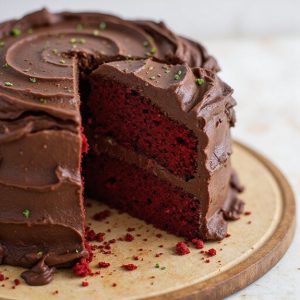
Rich Fudge Frosting Red Velvet Cake
Equipment
- 2 9-inch round cake pan
- 1 stand mixer or hand mixer
- 3 Mixing bowl
- 1 Whisk
- 1 Rubber spatula
- 1 Wire rack
- 1 Measuring cups set
- 1 Measuring spoons set
- 1 Sifter
- 1 parchment paper sheet
- 1 Small saucepan
- 1 offset spatula
- 1 Serrated knife
Ingredients
- 2 1/2 cup all-purpose flour sifted
- 1 1/2 cup granulated sugar
- 1 teaspoon baking soda
- 1 teaspoon fine salt
- 1 tablespoon natural cocoa powder
- 1 1/2 cup vegetable oil
- 1 cup buttermilk room temperature
- 2 large eggs room temperature
- 2 tablespoon red liquid food coloring
- 1 teaspoon white vinegar
- 2 teaspoon vanilla extract
- 1/2 cup unsalted butter softened
- 1/2 cup unsalted butter cubed, for fudge frosting
- 1/2 cup vegetable shortening optional, for extra tenderness
- 1 cup whole milk room temperature
- 2 cup powdered sugar sifted
- 1 cup sour cream room temperature
- 8 ounce semisweet chocolate chopped
- 1/2 cup heavy cream
- 1/4 cup cocoa powder, Dutch-process for frosting
- 1/2 teaspoon fine salt for frosting
- 1 teaspoon vanilla extract for frosting
Instructions
- Preheat the oven to 350°F and line two 9-inch cake pans with parchment circles and lightly grease the sides.
- In a large bowl whisk together flour, granulated sugar, baking soda, salt, and natural cocoa powder until evenly combined.
- In a separate bowl whisk oil, buttermilk, eggs, red food coloring, vinegar, and vanilla until smooth and cohesive.
- Pour the wet mixture into the dry mixture and mix on low just until a smooth batter forms without overmixing.
- Divide the batter evenly between the prepared pans, smooth the tops, and tap each pan to release large air bubbles.
- Bake for 25 to 30 minutes until a toothpick inserted in the center comes out with a few moist crumbs.
- Cool cakes in pans for 10 minutes, then invert onto a wire rack, peel off parchment, and cool completely.
- For the fudge frosting, place chopped semisweet chocolate in a heatproof bowl and heat heavy cream in a small saucepan until steaming.
- Pour the hot cream over the chocolate, let sit 2 minutes, then whisk from the center outward until glossy and smooth.
- In a mixer beat 1/2 cup cubed butter until creamy, then add cocoa powder, salt, and vanilla and beat until combined.
- With the mixer on low, stream in the chocolate ganache, then add sour cream and beat until fully incorporated and silky.
- Gradually add powdered sugar and beat on medium-high until the frosting is thick, spreadable, and fudge-like.
- If the frosting seems soft, chill for 10 to 15 minutes, stirring once, until it holds swirls.
- Level cake layers with a serrated knife if needed and place one layer on a serving board.
- Spread a generous layer of fudge frosting over the first layer, top with the second layer, and press gently to set.
- Apply a thin crumb coat of frosting over the top and sides and chill for 20 minutes to lock in crumbs.
- Finish with a thick final coat of frosting, smoothing with an offset spatula or creating swoops as desired.
- Let the cake rest for at least 1 hour before slicing to allow the frosting to set and flavors to meld.

